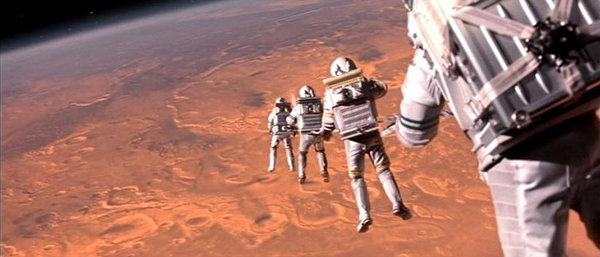
Days of De Palma (Part 15): Mission to Mars (2000)
My journey through all the films of Brian De Palma continues! (Scroll down to the bottom to see links to all of my previous reviews.) Following 1998’s Snake Eyes, a film with a poor critical reputation that I don’t think is at all deserved, we come to Mission to Mars, a film that also has a poor critical reputation. But whereas I unabashedly love Snake Eyes, I can’t quite say the same for Mission to Mars. It’s nowhere near as terrible as many people like to say it is, but nonetheless it doesn’t quite work.
Gary Sinese (re-teaming with Brian De Palma following his role in Snake Eyes) plays Jim McConnell, an astronaut whose wife has recently been killed. His friends head off on the first manned mission to Mars, but when tragedy strikes a rescue/recovery mission is organized with Jim’s involvement, along with his friend Commander Woody Blake (Tim Robins), Blake’s wife Terri Fisher (Connie Nielson), and Phil Ohlmeyer (Jerry O’Connell).
It’s interesting to see Mr. De Palma’s style applied to a sci-fi film. Mr. De Palma’s eye and style give Mission to Mars a different feel than your average big-budget sci-fi flick. There’s a lot to enjoy about the film. While the story isn’t that sophisticated, the mystery of what happened to the original crew on Mars is enough to hold my interest throughout the film. Similarly, none of the characters are that interesting or complex, but there’s enough movie-star charisma on display — between the afore-mentioned Gary Sinese, Tom Robbins, Connie Nielson, and Jerry O’Connell, plus also Don Cheadle, Armin Mueller-Stahl, and others — to keep the audience hooked in. However, I dearly miss the sharp work that David Koepp did on the screenplays of Mr. De Palma’s last three films (Carlito’s Way, Mission: Impossible, and Snake Eyes). (I groaned when, during the hull breach situation, Tim Robbins’ character says: “Come on, people, let’s work the problem,” a direct and obvious rip-off from Apollo 13. Not the script’s finest moment.)
Both The Bonfire of the Vanities and Snake Eyes opened with a lengthy single-take tracking shot designed to introduce the characters and setting, and so too does this film, as we meet all of the main characters at a BBQ party before the original mission to Mars’ launch. This device feels a little cliche for Brian De Palma at this point, so not nearly as effective as before (nor does it have the jaw-dropping audaciousness of Snake Eyes’ opening shot that somehow involved thousands of extras in the boxing arena), but it’s still fun to see and a neat method of introducing us to all the main characters.
In terms of signature Brian De Palma impressive sequences, I was more taken with the panning shot moving through the circular set of the Mars Recovery Vehicle. That was a cool moment and a nice spin on the classic Kubrick shot from 2001: A Space Odyssey. There are several more lovely, patient tracking shots through the space-ship. Mr. De Palma’s floating camera is used to great effect in simulating the effects of the characters being in zero gravity, and in selling the reality of the space-ship sets.
We also get a classic De Palma split focus moment when we see Gary Sinese in the foreground, watching a video of his character’s wife, with Tim Robbins in the background.
The movie is pretty solid until the rescue mission arrives at Mars, and then things get a little silly. The characters make a series of fairly dumb mistakes that result in catastrophe. I am always annoyed by movies in which the characters act stupider than they should. We also start entering into plot-hole land. (Prime example: I thought all the computers were fried, but Luke (Don Cheadle) was able to create a DNA model on a computer!)
Although Brian De Palma feels like a bizarre match with a visual-effects-laden, big-budget popcorn movie, for the most part, Mission to Mars looks pretty great. The visual effects are mostly solid, and the outer-space shots as well as the vistas of Mars all look pretty great. There’s a nice CGI shot towards the end, in which we see the continuous morphing of human evolution; it’s a pretty cool moment. The actual Martian that we gets to see leaves a little bit to be desired, though — it’s one moment in which the film’s visual effects reach seems to exceed its grasp.
I like that this film doesn’t end with a huge action sequence, but rather an exploration of different ideas. This is how I like my sci-fi.
It’s weird hearing Ennio Morricone score a sci-fi film, but somehow it works for me! I like the juxtaposition of styles, and it helps create the sense that Mr. De Palma did not set out to create a generic, cookie-cutter sci-fi film.
I wouldn’t say Mission to Mars is a highlight of Mr. De Palma’s career, but it’s definitely not one of his big stinkers. This is not a classic sci-fi film by any stretch of the imagination, but it’s reasonably intelligent and entertaining. It’s a better film than its reputation would have you believe. I had only seen it once, back in 2000 when it was originally released, and I’m very pleased to have seen it again.
Days of De Palma: Part 1 — Carrie (1976); Part 2 — The Fury (1978); Part 3 — Dressed to Kill (1980); Part 4 — Blow Out (1981); Part 5 – Scarface (1983); Part 6 – Body Double (1984); Part 7 – Wise Guys (1986); Part 8 — The Untouchables (1987); Part 9 — Casualties of War (1989); Part 10 — The Bonfire of the Vanities (1990); Part 11 — Raising Cain (1992); Part 12 — Carlito’s Way (1993); Part 13 — Mission: Impossible (1996); Part 14 — Snake Eyes (1998).
